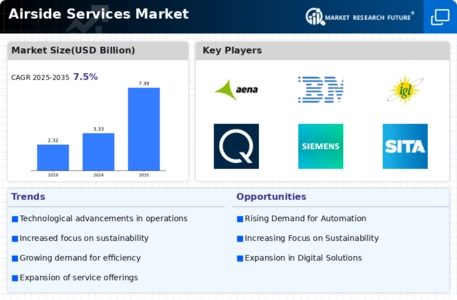Market Trends
Key Emerging Trends in the Airside Services Market
The airside services market is experiencing significant growth and transformation, driven by increasing air travel demand, expansion of airport infrastructure, and advancements in ground handling technologies. Airside services encompass a wide range of activities and operations conducted on airport grounds to ensure the safe, efficient, and timely movement of aircraft, passengers, and cargo. One notable trend in this market is the increasing focus on automation, digitalization, and sustainability to optimize airport operations and enhance passenger experience.
One of the key drivers of growth in the airside services market is the rapid expansion of air travel globally, fueled by rising disposable incomes, urbanization, and globalization. With increasing air traffic volumes and congestion at airports, there is a growing demand for efficient and reliable airside services to minimize turnaround times, improve aircraft utilization, and enhance overall airport capacity. Ground handling companies, airport operators, and service providers are investing in advanced equipment, infrastructure, and technology to meet the growing demand for airside services and ensure smooth operations on the apron, taxiways, and runways.
Moreover, advancements in ground handling equipment and technologies are driving innovation and differentiation in the airside services market. Ground handling companies are deploying state-of-the-art equipment such as aircraft tugs, baggage handling systems, and ground support vehicles equipped with advanced navigation, tracking, and communication capabilities to improve operational efficiency and safety on the airside. Additionally, the integration of digital platforms, mobile applications, and real-time tracking systems enables ground handlers to streamline workflows, optimize resource allocation, and enhance communication between airport stakeholders, further improving overall service quality and reliability.
Another significant trend in the airside services market is the adoption of sustainable practices and eco-friendly initiatives to reduce environmental impact and carbon emissions at airports. With increasing awareness of climate change and environmental sustainability, airports and airlines are implementing measures to minimize carbon footprint and promote environmental stewardship in airside operations. Ground handling companies are investing in electric and hybrid ground support equipment, alternative fuels, and renewable energy sources to reduce greenhouse gas emissions, noise pollution, and fuel consumption on the airside. Additionally, initiatives such as single-engine taxiing, green taxiing systems, and ground-based power supply (GBPS) systems help minimize aircraft emissions and energy consumption during ground operations, contributing to a greener and more sustainable airside environment.
Furthermore, the COVID-19 pandemic has accelerated the adoption of contactless and touchless technologies in airside services to enhance health and safety measures and minimize the risk of virus transmission. Ground handling companies are implementing touchless check-in kiosks, self-service bag drops, and biometric authentication systems to reduce physical contact and streamline passenger processing at airports. Additionally, the deployment of autonomous ground vehicles, drones, and robotics for baggage handling, aircraft towing, and runway inspections enables contactless operations and social distancing measures on the airside, ensuring the safety and well-being of passengers, airport staff, and ground handlers.

















Leave a Comment